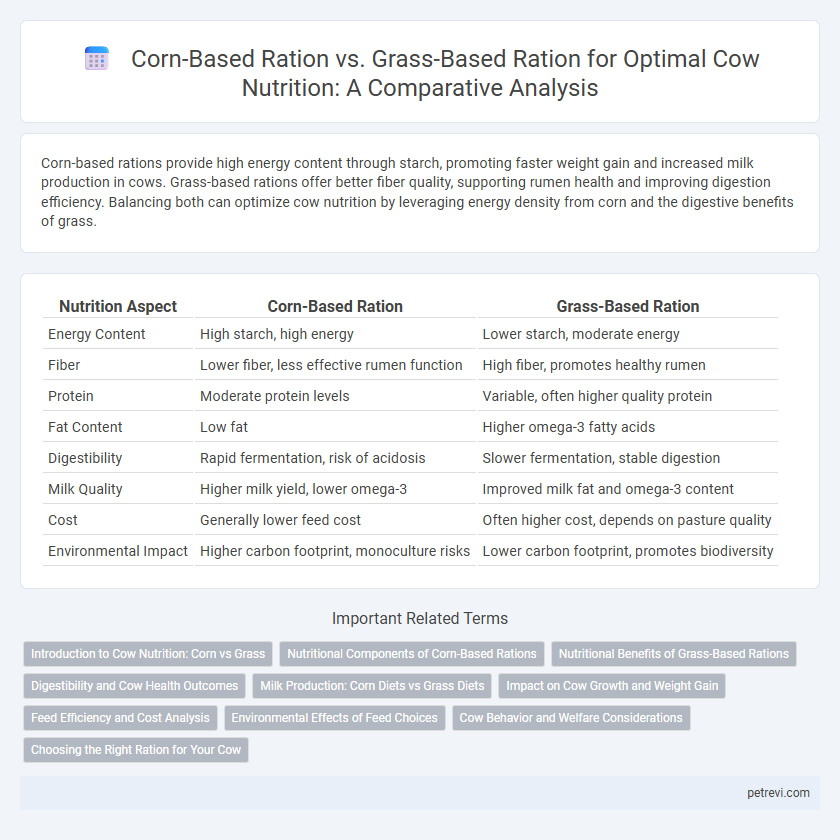Corn-based rations provide high energy content through starch, promoting faster weight gain and increased milk production in cows. Grass-based rations offer better fiber quality, supporting rumen health and improving digestion efficiency. Balancing both can optimize cow nutrition by leveraging energy density from corn and the digestive benefits of grass.
Table of Comparison
| Nutrition Aspect | Corn-Based Ration | Grass-Based Ration |
|---|---|---|
| Energy Content | High starch, high energy | Lower starch, moderate energy |
| Fiber | Lower fiber, less effective rumen function | High fiber, promotes healthy rumen |
| Protein | Moderate protein levels | Variable, often higher quality protein |
| Fat Content | Low fat | Higher omega-3 fatty acids |
| Digestibility | Rapid fermentation, risk of acidosis | Slower fermentation, stable digestion |
| Milk Quality | Higher milk yield, lower omega-3 | Improved milk fat and omega-3 content |
| Cost | Generally lower feed cost | Often higher cost, depends on pasture quality |
| Environmental Impact | Higher carbon footprint, monoculture risks | Lower carbon footprint, promotes biodiversity |
Introduction to Cow Nutrition: Corn vs Grass
Corn-based rations provide high energy density and starch content, promoting rapid weight gain and increased milk production in cows. Grass-based rations offer higher fiber levels and essential nutrients, supporting better rumen health and improved digestion. Balancing corn and grass in cow nutrition optimizes energy intake while maintaining gut function and overall animal well-being.
Nutritional Components of Corn-Based Rations
Corn-based rations for cow nutrition are rich in starch, providing a high-energy source that supports rapid weight gain and milk production. These rations typically contain about 70-80% starch, along with moderate levels of protein (8-12%) and low fiber content, which enhances digestibility but can lead to ruminal acidosis if not properly managed. Essential vitamins such as vitamin A and minerals like phosphorus are also present, making corn-based diets effective for maximizing energy intake but requiring careful balance to maintain rumen health.
Nutritional Benefits of Grass-Based Rations
Grass-based rations provide cows with higher levels of essential fatty acids, antioxidants, and fiber compared to corn-based diets, promoting better rumen health and milk quality. These diets typically enhance the omega-3 fatty acid and conjugated linoleic acid (CLA) content in milk, which is beneficial for human health. Improved fiber digestion in grass-based rations supports more stable rumen pH and reduces the risk of acidosis, contributing to overall bovine well-being and productivity.
Digestibility and Cow Health Outcomes
Corn-based rations offer higher energy density and improved starch digestibility, promoting faster weight gain and increased milk production in cows compared to grass-based rations. Grass-based diets provide better fiber content that supports rumen health and reduces the risk of acidosis, enhancing overall digestive efficiency and immune function. Balancing corn-based feeds with adequate forage is essential to optimize nutrient absorption and maintain long-term cow health outcomes.
Milk Production: Corn Diets vs Grass Diets
Corn-based rations provide higher energy density compared to grass-based diets, which often results in increased milk yield due to enhanced glucose availability for lactose synthesis. Milk from cows on corn diets tends to have higher fat content, as starch fermentation promotes acetate production, a key precursor for milk fat synthesis. Conversely, grass-based rations improve milk's omega-3 fatty acid profile and conjugated linoleic acid (CLA) levels, benefiting milk nutritional quality despite typically lower volume production.
Impact on Cow Growth and Weight Gain
Corn-based rations provide higher energy density and digestible starch, promoting faster growth rates and greater weight gain in cows compared to grass-based rations. Grass-based diets, rich in fiber and lower in energy, support gradual growth and improved rumen health but may result in slower weight gain. Optimizing nutritional balance between corn and forage is essential to enhance growth performance and overall cow health.
Feed Efficiency and Cost Analysis
Corn-based rations offer higher energy density, resulting in improved feed efficiency with greater milk yield per unit of feed compared to grass-based rations. Grass-based diets, while lower in energy, can reduce overall feed costs due to cheaper forage availability and lower input expenses. Evaluating corn versus grass-based rations involves balancing the higher feed efficiency of grain with the cost savings of pasture feeding to optimize dairy production economics.
Environmental Effects of Feed Choices
Corn-based rations for cows typically result in higher greenhouse gas emissions due to fossil fuel-intensive crop production and increased nitrous oxide release from fertilized fields. Grass-based rations promote soil carbon sequestration and support biodiversity, leading to a lower overall environmental footprint. Life cycle assessments indicate that transitioning to grass-based feed can reduce methane emissions per unit of milk produced by improving rumen fermentation efficiency.
Cow Behavior and Welfare Considerations
Corn-based rations often lead to increased energy intake, which can cause altered cow behaviors such as reduced rumination and increased risk of digestive disturbances, negatively impacting welfare. Grass-based rations promote natural foraging behavior, improve cud-chewing activity, and support rumen health, enhancing overall well-being. Welfare considerations emphasize the importance of diet composition to prevent stress and maintain normal behavioral patterns in cows.
Choosing the Right Ration for Your Cow
Corn-based ration provides higher energy density essential for maximizing milk production in dairy cows, promoting rapid weight gain and improved feed efficiency. Grass-based ration offers superior fiber content, enhancing rumen health and supporting natural grazing behavior, critical for digestive function and overall wellbeing. Choosing the right ration depends on production goals, cow breed, and pasture availability to balance nutrient requirements and optimize health and productivity.
Corn-based ration vs Grass-based ration for Cow nutrition Infographic

 petrevi.com
petrevi.com